Abstract
1. Previous work has shown that the H reflex excitability of the human soleus motoneurones is reduced during fatigue and is accompanied by a corresponding decrease in electromyographic (EMG) activity during maximal voluntary contractions. These findings were consistent with the existence of a reflex whereby alpha-motoneurones are inhibited by sensory input from the fatigued muscle. 2. To elucidate the contribution of different-sized afferents in such reflex inhibition, compression of the sciatic nerve was used in an attempt to block large myelinated afferents prior to fatigue. 3. Fatigue of the soleus muscle was induced under ischaemic conditions by intermittent electrical stimulation at 15 Hz in ten healthy subjects. These subjects also participated in a control test in which the compression block was followed by ischaemia without fatigue. 4. Following nerve compression alone, both the mean maximal plantarflexion torque and the associated EMG for all ten subjects declined by 18.8 +/- 16.2% (S.D.) and 13.4 +/- 17.2%, respectively. 5. Following fatigue, there were five subjects in whom the large afferents remained blocked and the experimental findings were consistent with the existence of reflex inhibition during fatigue. The mean maximal plantarflexion torque decreased further by 36.2 +/- 7.6% from the value following the compression block compared to a decrease of 5.0 +/- 9.9% in the ischaemia control. The mean EMG associated with these contractions also decreased from post-block values by 56.8 +/- 19.6% following fatigue and by only 6.4 +/- 8.0% following ischaemia alone. 6. The peripheral excitability of the neuromuscular junction and muscle fibre membrane was adequate following fatigue as evidenced by only modest changes in the M wave (muscle compound action potential). The descending motor drive was deemed sufficient because of the absence of any large interpolated twitches superimposed upon the maximal voluntary contraction in all but two subjects. 7. The declines in maximal plantarflexion torque and the associated EMG activity were very similar to those found in a previous study in which the sensory input was unaltered. The findings demonstrated that any reflex inhibition of the alpha-motoneurone pool during fatigue was probably not mediated by large diameter afferents. Rather, it is suggested that the reflex is mediated by smaller diameter afferents originating from the fatigued muscle.
Full text
PDF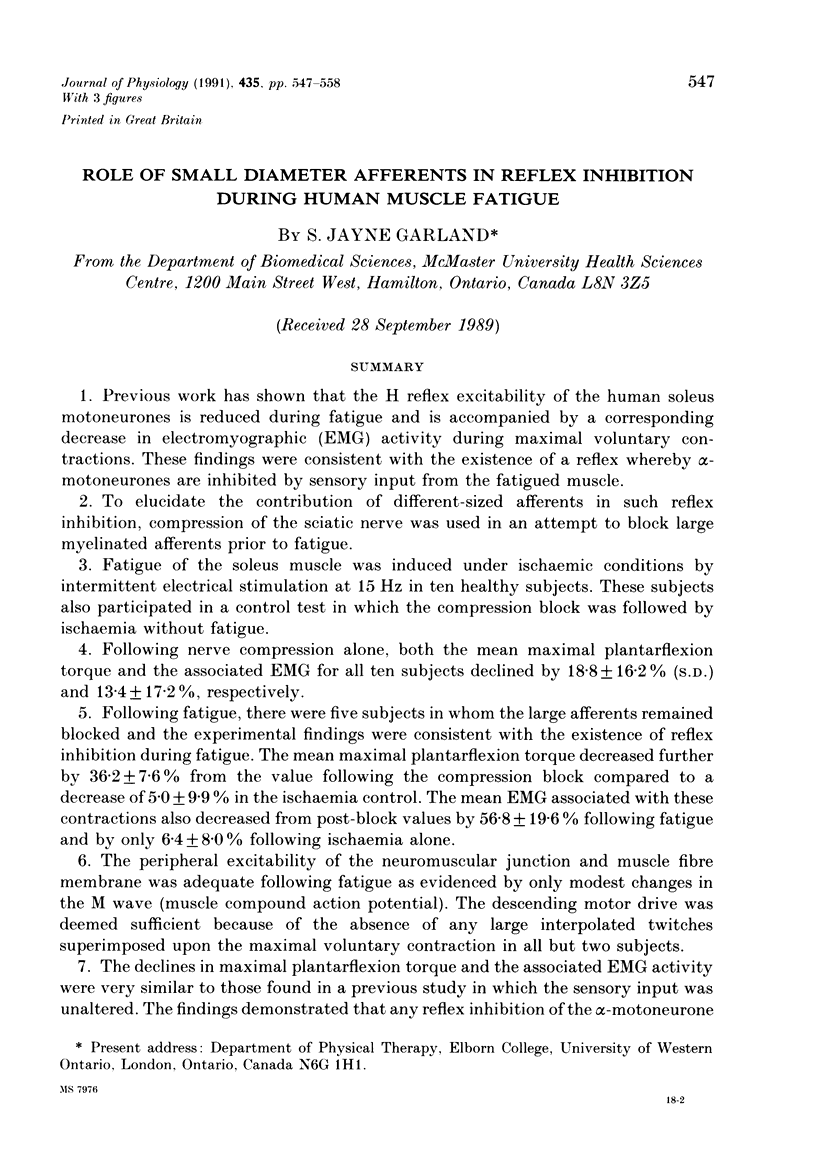

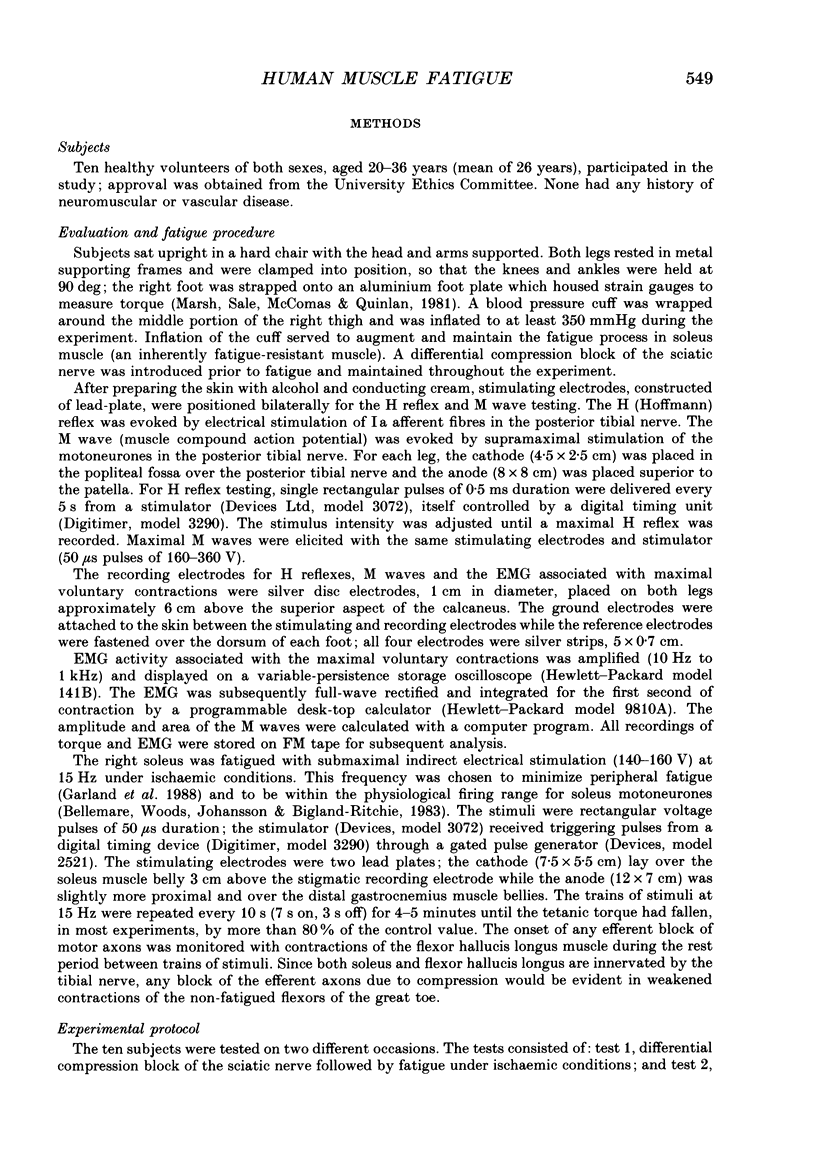
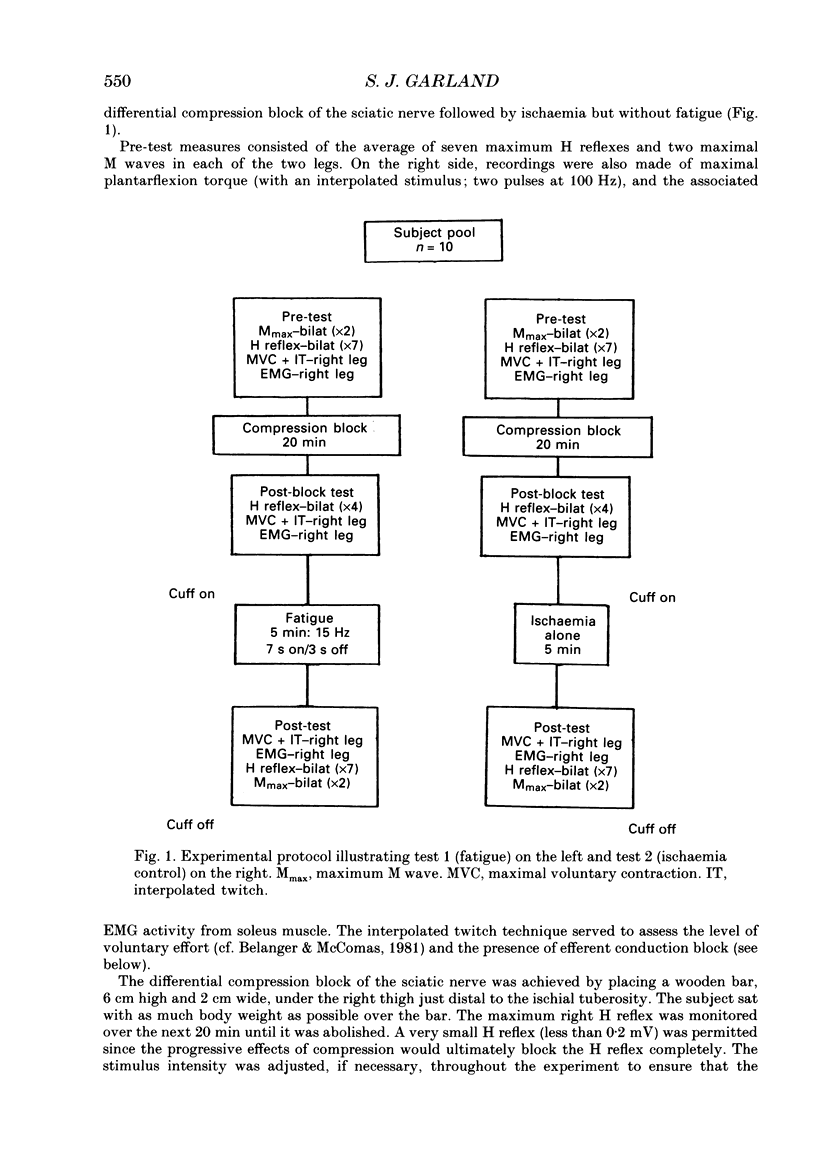
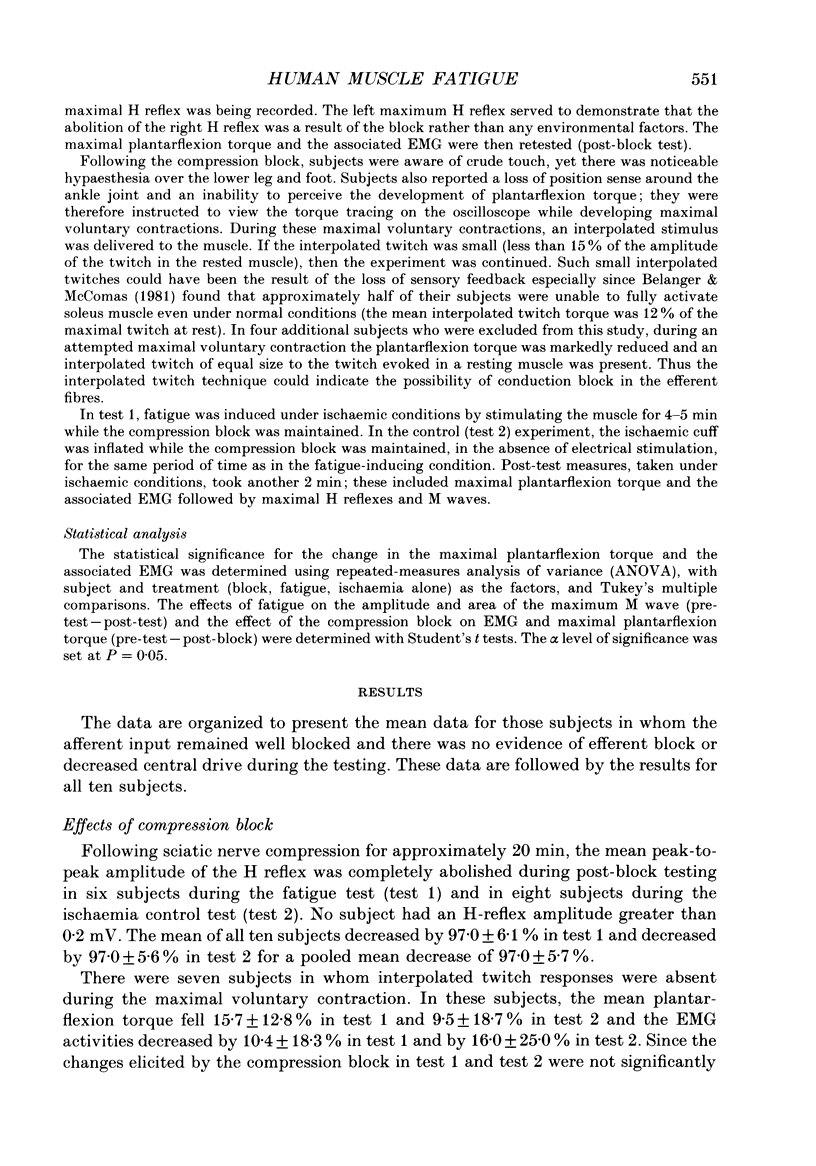
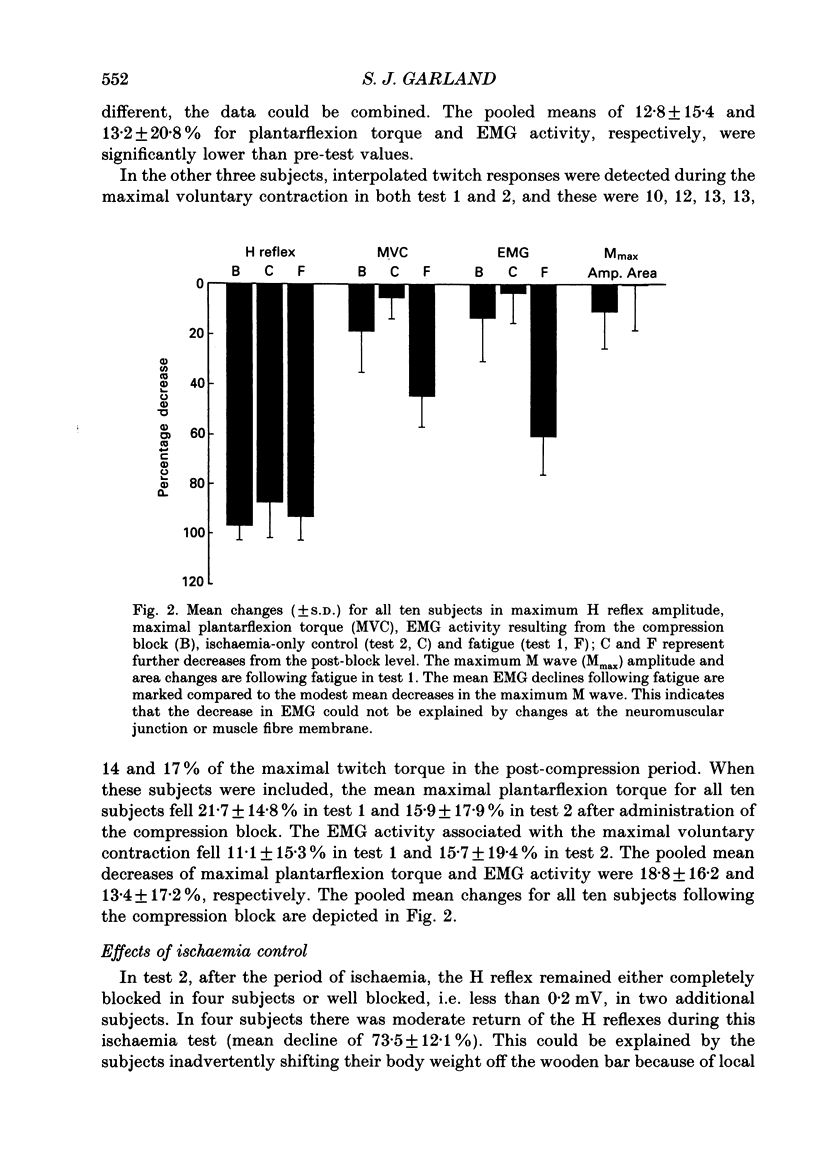
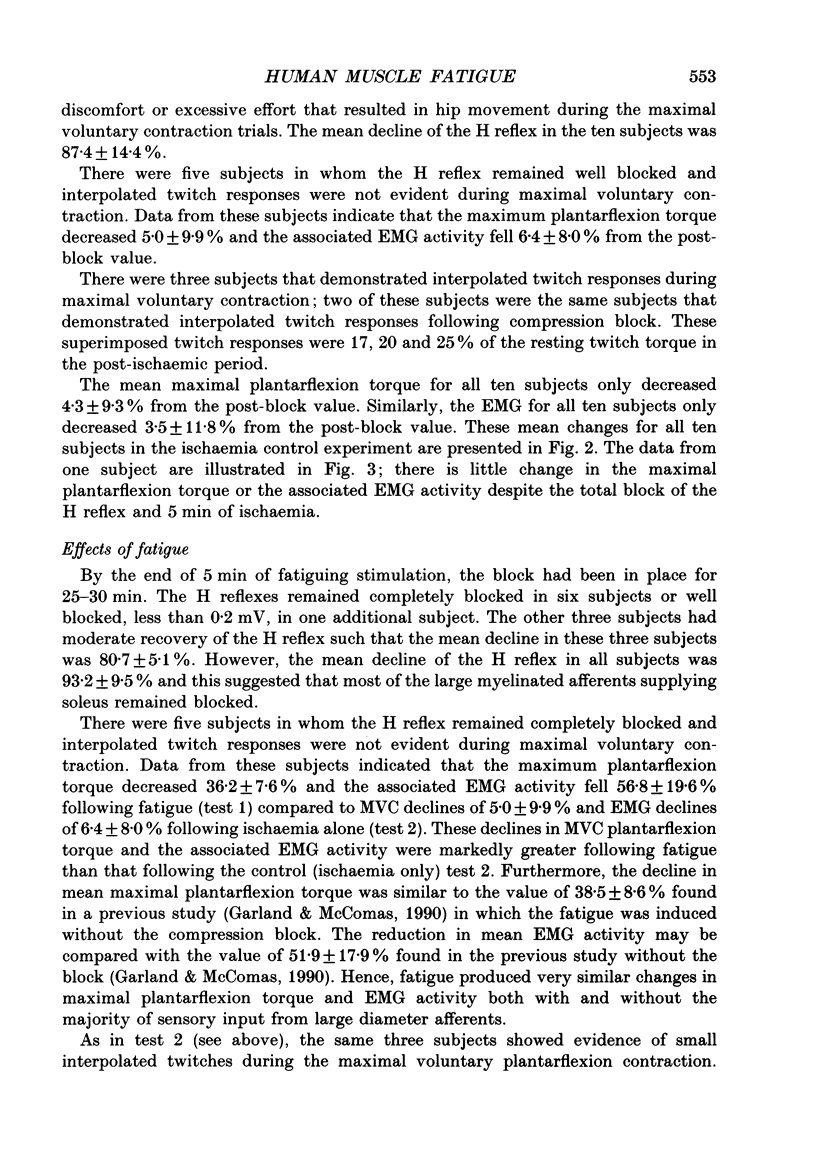
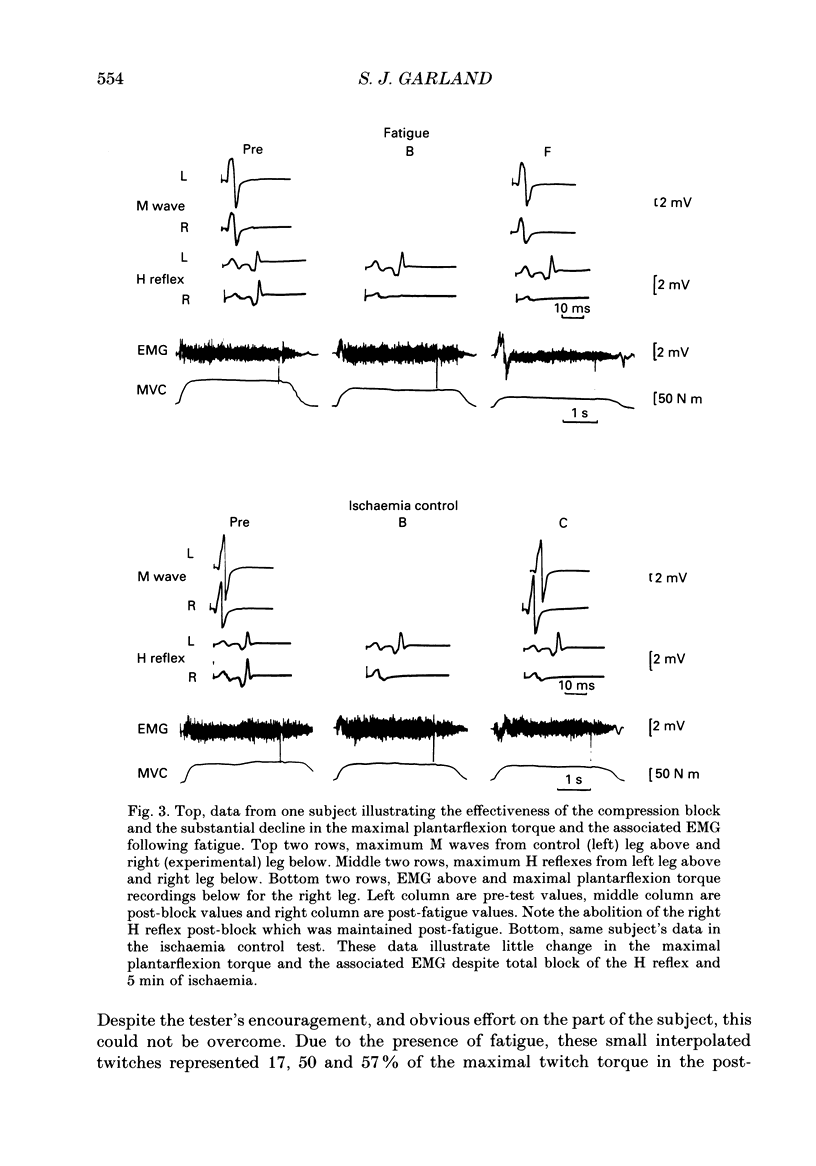
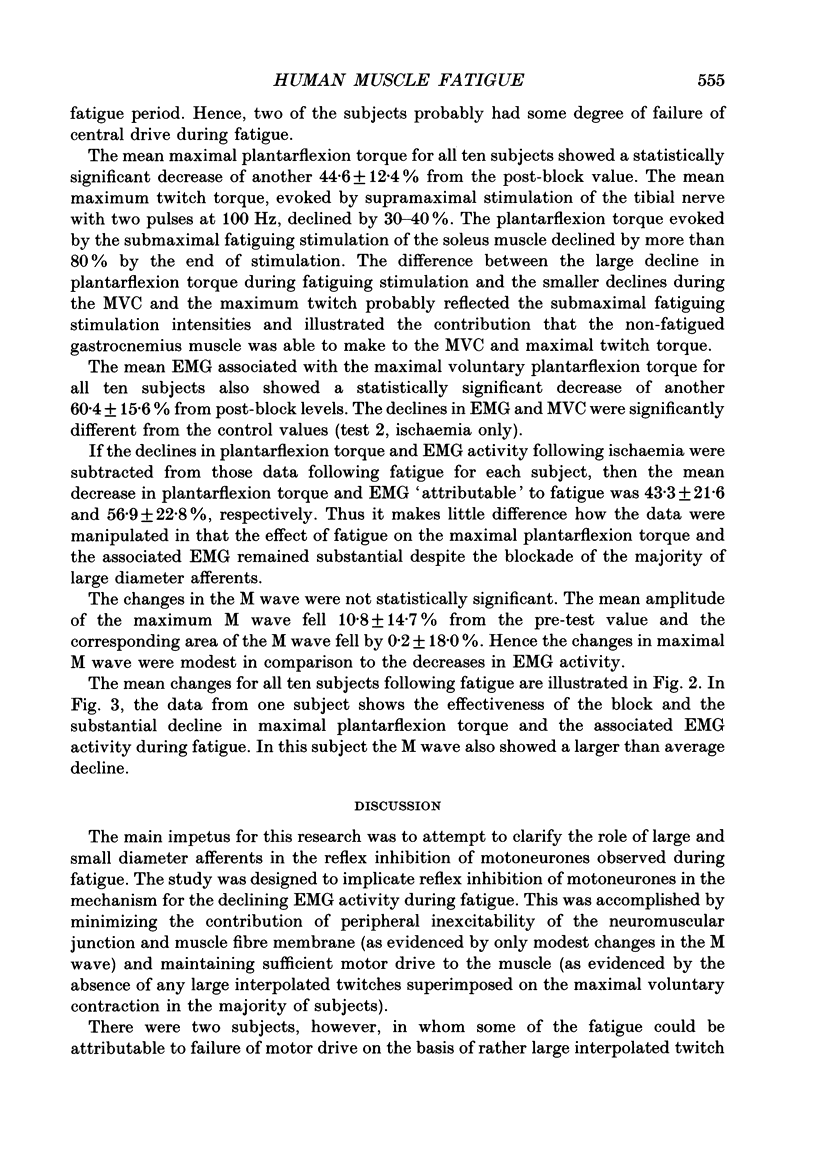
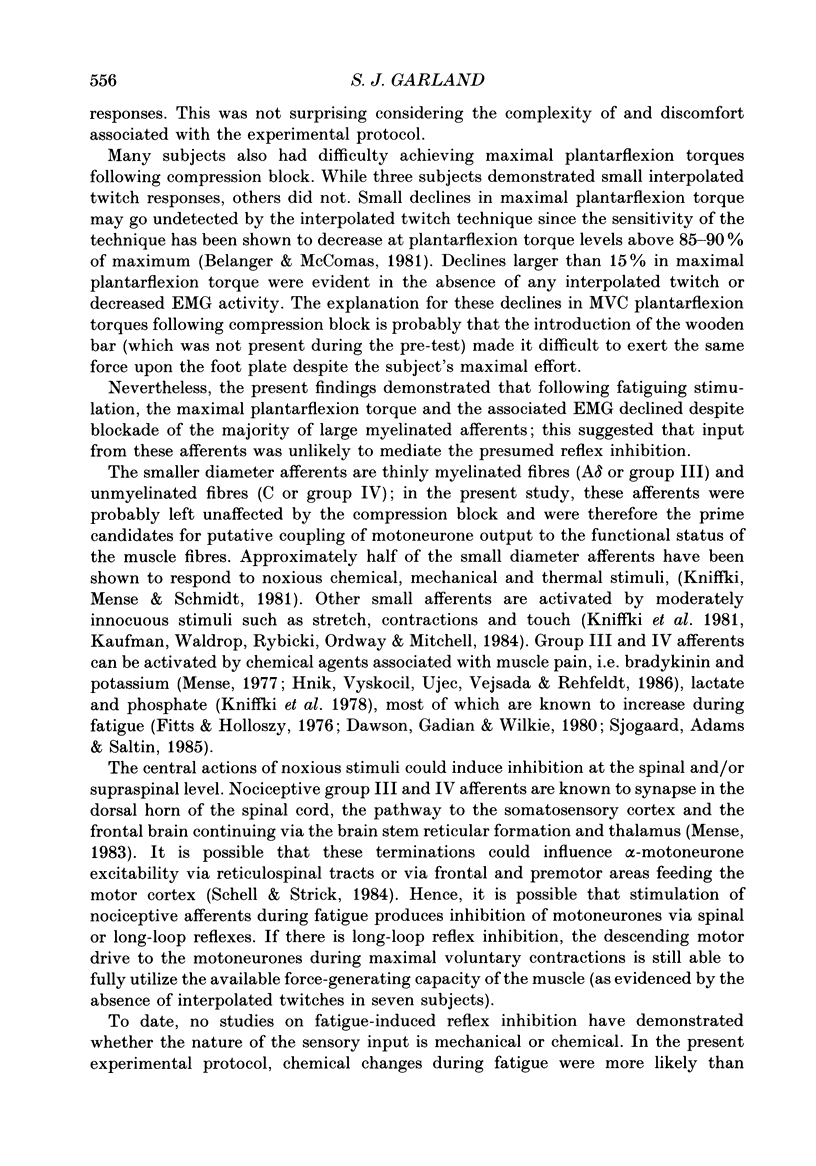
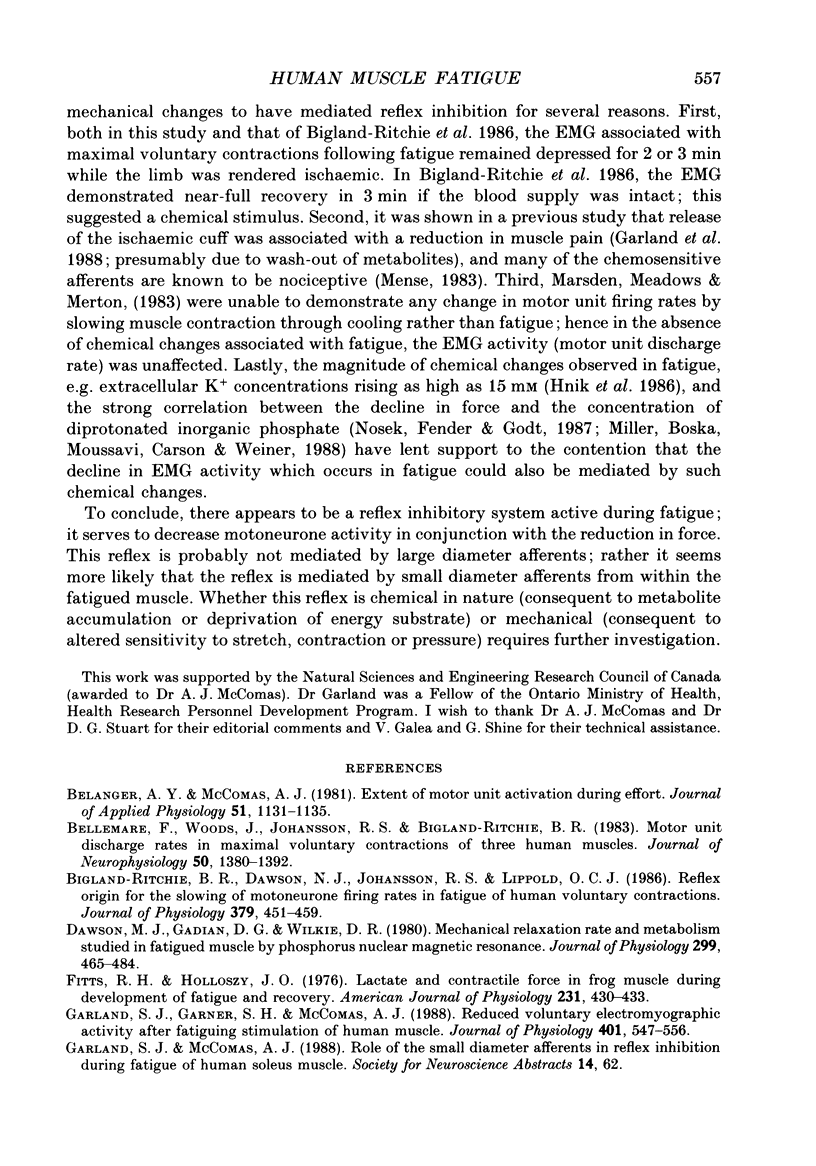
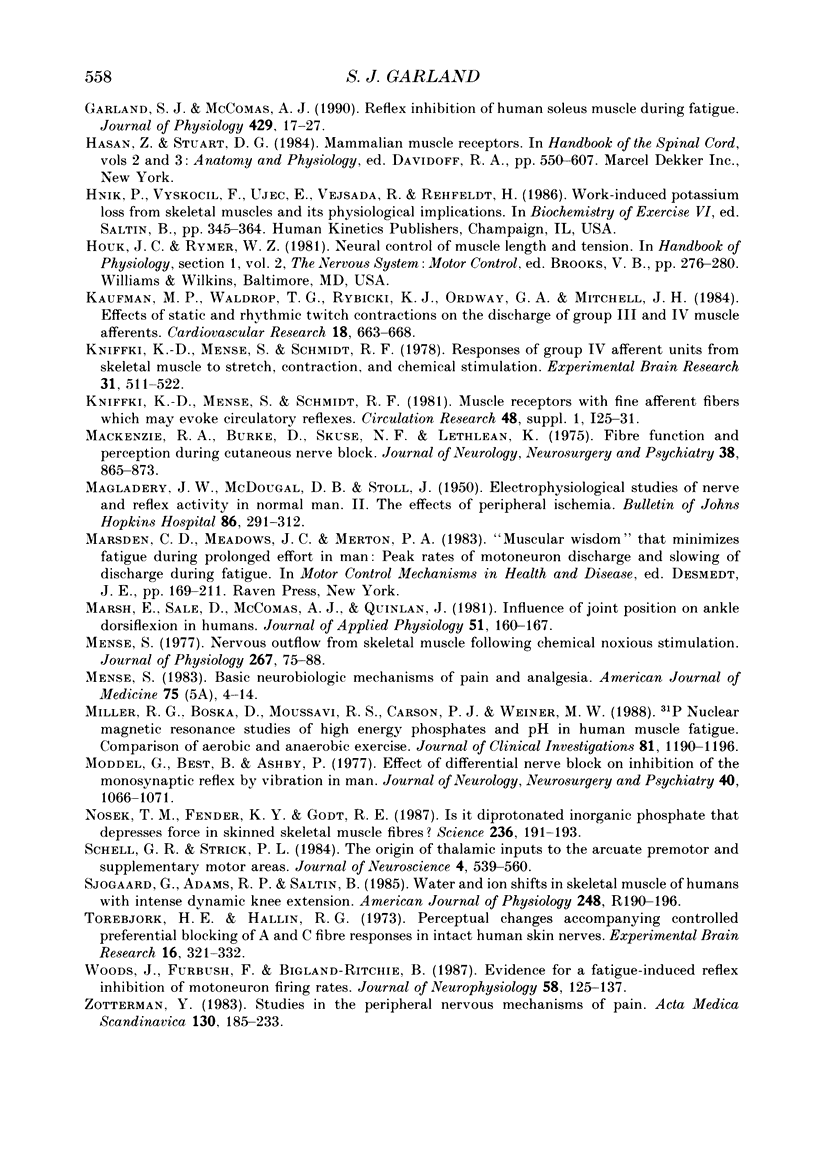
Selected References
These references are in PubMed. This may not be the complete list of references from this article.
- Belanger A. Y., McComas A. J. Extent of motor unit activation during effort. J Appl Physiol Respir Environ Exerc Physiol. 1981 Nov;51(5):1131–1135. doi: 10.1152/jappl.1981.51.5.1131. [DOI] [PubMed] [Google Scholar]
- Bellemare F., Woods J. J., Johansson R., Bigland-Ritchie B. Motor-unit discharge rates in maximal voluntary contractions of three human muscles. J Neurophysiol. 1983 Dec;50(6):1380–1392. doi: 10.1152/jn.1983.50.6.1380. [DOI] [PubMed] [Google Scholar]
- Bigland-Ritchie B. R., Dawson N. J., Johansson R. S., Lippold O. C. Reflex origin for the slowing of motoneurone firing rates in fatigue of human voluntary contractions. J Physiol. 1986 Oct;379:451–459. doi: 10.1113/jphysiol.1986.sp016263. [DOI] [PMC free article] [PubMed] [Google Scholar]
- Dawson M. J., Gadian D. G., Wilkie D. R. Mechanical relaxation rate and metabolism studied in fatiguing muscle by phosphorus nuclear magnetic resonance. J Physiol. 1980 Feb;299:465–484. doi: 10.1113/jphysiol.1980.sp013137. [DOI] [PMC free article] [PubMed] [Google Scholar]
- Fitts R. H., Holloszy J. O. Lactate and contractile force in frog muscle during development of fatigue and recovery. Am J Physiol. 1976 Aug;231(2):430–433. doi: 10.1152/ajplegacy.1976.231.2.430. [DOI] [PubMed] [Google Scholar]
- Garland S. J., Garner S. H., McComas A. J. Reduced voluntary electromyographic activity after fatiguing stimulation of human muscle. J Physiol. 1988 Jul;401:547–556. doi: 10.1113/jphysiol.1988.sp017178. [DOI] [PMC free article] [PubMed] [Google Scholar]
- Garland S. J., McComas A. J. Reflex inhibition of human soleus muscle during fatigue. J Physiol. 1990 Oct;429:17–27. doi: 10.1113/jphysiol.1990.sp018241. [DOI] [PMC free article] [PubMed] [Google Scholar]
- Kaufman M. P., Waldrop T. G., Rybicki K. J., Ordway G. A., Mitchell J. H. Effects of static and rhythmic twitch contractions on the discharge of group III and IV muscle afferents. Cardiovasc Res. 1984 Nov;18(11):663–668. doi: 10.1093/cvr/18.11.663. [DOI] [PubMed] [Google Scholar]
- Kniffki K. D., Mense S., Schmidt R. F. Responses of group IV afferent units from skeletal muscle to stretch, contraction and chemical stimulation. Exp Brain Res. 1978 Apr 14;31(4):511–522. doi: 10.1007/BF00239809. [DOI] [PubMed] [Google Scholar]
- MAGLADERY J. W., McDOUGAL D. B., Jr, STOLL J. Electrophysiological studies of nerve and reflex activity in normal man. II. The effects of peripheral ischemia. Bull Johns Hopkins Hosp. 1950 May;86(5):291–312. [PubMed] [Google Scholar]
- Mackenzie R. A., Burke D., Skuse N. F., Lethlean A. K. Fibre function and perception during cutaneous nerve block. J Neurol Neurosurg Psychiatry. 1975 Sep;38(9):865–873. doi: 10.1136/jnnp.38.9.865. [DOI] [PMC free article] [PubMed] [Google Scholar]
- Marsden C. D., Meadows J. C., Merton P. A. "Muscular wisdom" that minimizes fatigue during prolonged effort in man: peak rates of motoneuron discharge and slowing of discharge during fatigue. Adv Neurol. 1983;39:169–211. [PubMed] [Google Scholar]
- Marsh E., Sale D., McComas A. J., Quinlan J. Influence of joint position on ankle dorsiflexion in humans. J Appl Physiol Respir Environ Exerc Physiol. 1981 Jul;51(1):160–167. doi: 10.1152/jappl.1981.51.1.160. [DOI] [PubMed] [Google Scholar]
- Mense S. Basic neurobiologic mechanisms of pain and analgesia. Am J Med. 1983 Nov 14;75(5A):4–14. doi: 10.1016/0002-9343(83)90226-7. [DOI] [PubMed] [Google Scholar]
- Mense S. Nervous outflow from skeletal muscle following chemical noxious stimulation. J Physiol. 1977 May;267(1):75–88. doi: 10.1113/jphysiol.1977.sp011802. [DOI] [PMC free article] [PubMed] [Google Scholar]
- Miller R. G., Boska M. D., Moussavi R. S., Carson P. J., Weiner M. W. 31P nuclear magnetic resonance studies of high energy phosphates and pH in human muscle fatigue. Comparison of aerobic and anaerobic exercise. J Clin Invest. 1988 Apr;81(4):1190–1196. doi: 10.1172/JCI113434. [DOI] [PMC free article] [PubMed] [Google Scholar]
- Moddel G., Best B., Ashby P. Effect of differential nerve block on inhibition of the monosynaptic reflex by vibration in man. J Neurol Neurosurg Psychiatry. 1977 Nov;40(11):1066–1071. doi: 10.1136/jnnp.40.11.1066. [DOI] [PMC free article] [PubMed] [Google Scholar]
- Nosek T. M., Fender K. Y., Godt R. E. It is diprotonated inorganic phosphate that depresses force in skinned skeletal muscle fibers. Science. 1987 Apr 10;236(4798):191–193. doi: 10.1126/science.3563496. [DOI] [PubMed] [Google Scholar]
- Schell G. R., Strick P. L. The origin of thalamic inputs to the arcuate premotor and supplementary motor areas. J Neurosci. 1984 Feb;4(2):539–560. doi: 10.1523/JNEUROSCI.04-02-00539.1984. [DOI] [PMC free article] [PubMed] [Google Scholar]
- Sjøgaard G., Adams R. P., Saltin B. Water and ion shifts in skeletal muscle of humans with intense dynamic knee extension. Am J Physiol. 1985 Feb;248(2 Pt 2):R190–R196. doi: 10.1152/ajpregu.1985.248.2.R190. [DOI] [PubMed] [Google Scholar]
- Torebjörk H. E., Hallin R. G. Perceptual changes accompanying controlled preferential blocking of A and C fibre responses in intact human skin nerves. Exp Brain Res. 1973 Jan 29;16(3):321–332. doi: 10.1007/BF00233334. [DOI] [PubMed] [Google Scholar]
- Woods J. J., Furbush F., Bigland-Ritchie B. Evidence for a fatigue-induced reflex inhibition of motoneuron firing rates. J Neurophysiol. 1987 Jul;58(1):125–137. doi: 10.1152/jn.1987.58.1.125. [DOI] [PubMed] [Google Scholar]


